从跨文化交际看旅游英语翻译
- 格式:doc
- 大小:161.00 KB
- 文档页数:24
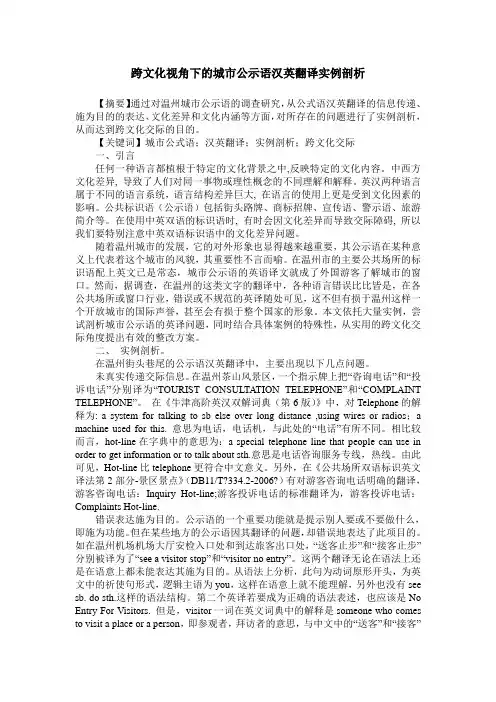
跨文化视角下的城市公示语汉英翻译实例剖析【摘要】通过对温州城市公示语的调查研究,从公式语汉英翻译的信息传递、施为目的的表达、文化差异和文化内涵等方面,对所存在的问题进行了实例剖析,从而达到跨文化交际的目的。
【关键词】城市公式语;汉英翻译;实例剖析;跨文化交际一、引言任何一种语言都植根于特定的文化背景之中,反映特定的文化内容。
中西方文化差异, 导致了人们对同一事物或理性概念的不同理解和解释。
英汉两种语言属于不同的语言系统,语言结构差异巨大, 在语言的使用上更是受到文化因素的影响。
公共标识语(公示语)包括街头路牌、商标招牌、宣传语、警示语、旅游简介等。
在使用中英双语的标识语时, 有时会因文化差异而导致交际障碍, 所以我们要特别注意中英双语标识语中的文化差异问题。
随着温州城市的发展,它的对外形象也显得越来越重要,其公示语在某种意义上代表着这个城市的风貌,其重要性不言而喻。
在温州市的主要公共场所的标识语配上英文已是常态,城市公示语的英语译文就成了外国游客了解城市的窗口。
然而,据调查,在温州的这类文字的翻译中,各种语言错误比比皆是,在各公共场所或窗口行业,错误或不规范的英译随处可见,这不但有损于温州这样一个开放城市的国际声誉,甚至会有损于整个国家的形象。
本文依托大量实例,尝试剖析城市公示语的英译问题,同时结合具体案例的特殊性,从实用的跨文化交际角度提出有效的整改方案。
二、实例剖析。
在温州街头巷尾的公示语汉英翻译中,主要出现以下几点问题。
未真实传递交际信息。
在温州茶山风景区,一个指示牌上把“咨询电话”和“投诉电话”分别译为“TOURIST CONSULTATION TELEPHONE”和“COMPLAINT TELEPHONE”。
在《牛津高阶英汉双解词典(第6版)》中,对Telephone的解释为: a system for talking to sb else over long distance ,using wires or radios;a machine used for this. 意思为电话,电话机,与此处的“电话”有所不同。
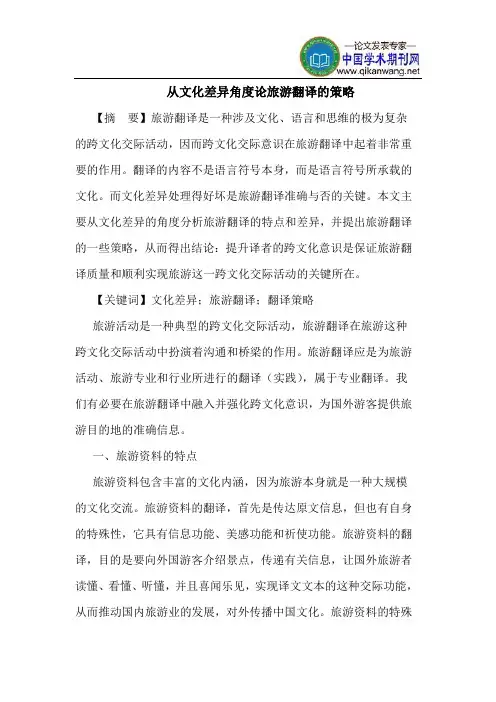
从文化差异角度论旅游翻译的策略【摘要】旅游翻译是一种涉及文化、语言和思维的极为复杂的跨文化交际活动,因而跨文化交际意识在旅游翻译中起着非常重要的作用。
翻译的内容不是语言符号本身,而是语言符号所承载的文化。
而文化差异处理得好坏是旅游翻译准确与否的关键。
本文主要从文化差异的角度分析旅游翻译的特点和差异,并提出旅游翻译的一些策略,从而得出结论:提升译者的跨文化意识是保证旅游翻译质量和顺利实现旅游这一跨文化交际活动的关键所在。
【关键词】文化差异;旅游翻译;翻译策略旅游活动是一种典型的跨文化交际活动,旅游翻译在旅游这种跨文化交际活动中扮演着沟通和桥梁的作用。
旅游翻译应是为旅游活动、旅游专业和行业所进行的翻译(实践),属于专业翻译。
我们有必要在旅游翻译中融入并强化跨文化意识,为国外游客提供旅游目的地的准确信息。
一、旅游资料的特点旅游资料包含丰富的文化内涵,因为旅游本身就是一种大规模的文化交流。
旅游资料的翻译,首先是传达原文信息,但也有自身的特殊性,它具有信息功能、美感功能和祈使功能。
旅游资料的翻译,目的是要向外国游客介绍景点,传递有关信息,让国外旅游者读懂、看懂、听懂,并且喜闻乐见,实现译文文本的这种交际功能,从而推动国内旅游业的发展,对外传播中国文化。
旅游资料的特殊性决定了在翻译中,不能传递异域文化的译文往往不能满足读者对不同国家文化的了解。
二、旅游翻译中的文化差异1.汉英旅游文体的语言特色和修辞差异。
由于东、西方文化差异的缘故,汉、英语之间存在着各自本身的异质性差异,这种差异又自然而然地制约着不同语言使用者对各自旅游文体独特的语言表现手法和写作风格。
一般而言,英语旅游文体大多风格简约,行文用字简洁明了,表达直观通俗,注重信息的准确性和语言的实用性。
同样是景观介绍,汉语则音韵和美,文辞华丽,诗意盎然,抒情表意唯恐不周;用声律和铺叙的手法来传情达意,讲究诗情画意的审美效果,主观抒发往往多于客观描述。
因此旅游翻译时在行文用字、篇章布局、文体修辞等方面都要做出相应的调整。
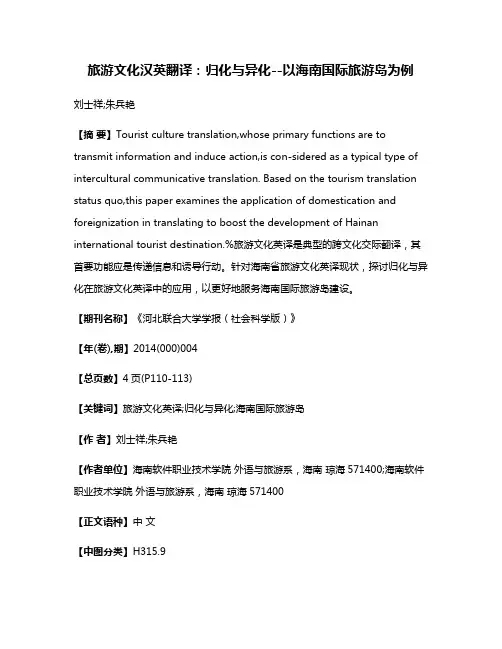
旅游文化汉英翻译:归化与异化--以海南国际旅游岛为例刘士祥;朱兵艳【摘要】Tourist culture translation,whose primary functions are to transmit information and induce action,is con-sidered as a typical type of intercultural communicative translation. Based on the tourism translation status quo,this paper examines the application of domestication and foreignization in translating to boost the development of Hainan international tourist destination.%旅游文化英译是典型的跨文化交际翻译,其首要功能应是传递信息和诱导行动。
针对海南省旅游文化英译现状,探讨归化与异化在旅游文化英译中的应用,以更好地服务海南国际旅游岛建设。
【期刊名称】《河北联合大学学报(社会科学版)》【年(卷),期】2014(000)004【总页数】4页(P110-113)【关键词】旅游文化英译;归化与异化;海南国际旅游岛【作者】刘士祥;朱兵艳【作者单位】海南软件职业技术学院外语与旅游系,海南琼海571400;海南软件职业技术学院外语与旅游系,海南琼海571400【正文语种】中文【中图分类】H315.9自2009年12月国务院发布《国务院关于推进海南国际旅游岛建设发展的若干意见》至今,已近3年。
海南接待外国游客从2010年的474015人次上升到2011年的561563人次,增长率约为16%。
但是,海南旅游相关翻译问题却令人触目惊心。
据报道,海南某著名景点“小心碰头”被译成“WATCH OUT,KNOCK HEAD”。
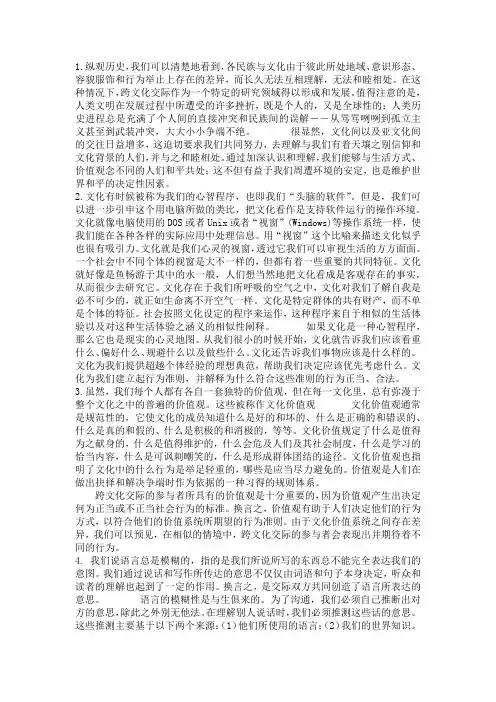
1.纵观历史,我们可以清楚地看到,各民族与文化由于彼此所处地域、意识形态、容貌服饰和行为举止上存在的差异,而长久无法互相理解,无法和睦相处。
在这种情况下,跨文化交际作为一个特定的研究领域得以形成和发展。
值得注意的是,人类文明在发展过程中所遭受的许多挫折,既是个人的,又是全球性的;人类历史进程总是充满了个人间的直接冲突和民族间的误解--从骂骂咧咧到孤立主义甚至到武装冲突,大大小小争端不绝。
很显然,文化间以及亚文化间的交往日益增多,这迫切要求我们共同努力,去理解与我们有着天壤之别信仰和文化背景的人们,并与之和睦相处。
通过加深认识和理解,我们能够与生活方式、价值观念不同的人们和平共处;这不但有益于我们周遭环境的安定,也是维护世界和平的决定性因素。
2.文化有时候被称为我们的心智程序,也即我们“头脑的软件”。
但是,我们可以进一步引申这个用电脑所做的类比,把文化看作是支持软件运行的操作环境。
文化就像电脑使用的DOS或者Unix或者“视窗”(Windows)等操作系统一样,使我们能在各种各样的实际应用中处理信息。
用“视窗”这个比喻来描述文化似乎也很有吸引力。
文化就是我们心灵的视窗,透过它我们可以审视生活的方方面面。
一个社会中不同个体的视窗是大不一样的,但都有着一些重要的共同特征。
文化就好像是鱼畅游于其中的水一般,人们想当然地把文化看成是客观存在的事实,从而很少去研究它。
文化存在于我们所呼吸的空气之中,文化对我们了解自我是必不可少的,就正如生命离不开空气一样。
文化是特定群体的共有财产,而不单是个体的特征。
社会按照文化设定的程序来运作,这种程序来自于相似的生活体验以及对这种生活体验之涵义的相似性阐释。
如果文化是一种心智程序,那么它也是现实的心灵地图。
从我们很小的时候开始,文化就告诉我们应该看重什么、偏好什么、规避什么以及做些什么。
文化还告诉我们事物应该是什么样的。
文化为我们提供超越个体经验的理想典范,帮助我们决定应该优先考虑什么。
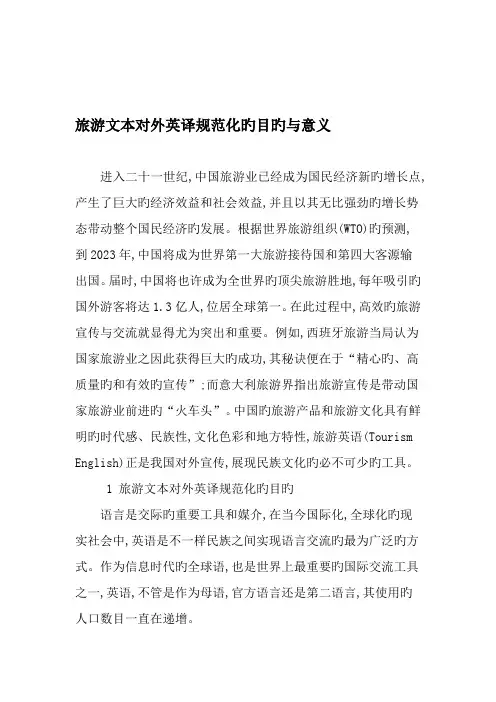
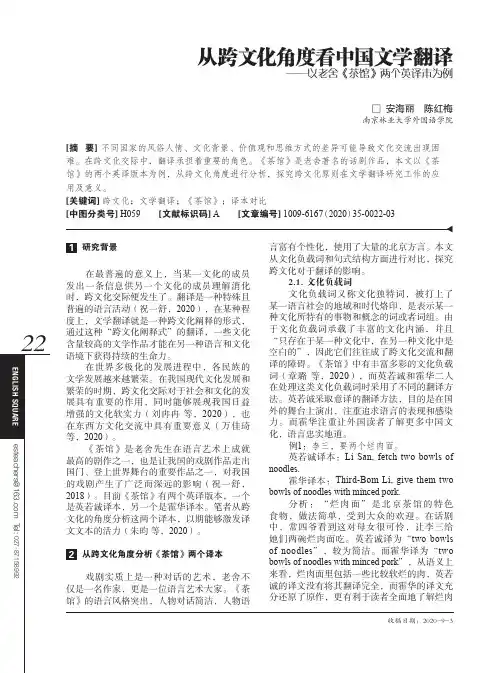
收稿日期:2020-9-31 研究背景在最普遍的意义上,当某一文化的成员发出一条信息供另一个文化的成员理解消化时,跨文化交际便发生了。
翻译是一种特殊且普遍的语言活动(祝一舒,2020),在某种程度上,文学翻译就是一种跨文化阐释的形式,通过这种“跨文化阐释式”的翻译,一些文化含量较高的文学作品才能在另一种语言和文化语境下获得持续的生命力。
在世界多极化的发展进程中,各民族的文学发展越来越繁荣。
在我国现代文化发展和繁荣的时期,跨文化交际对于社会和文化的发展具有重要的作用,同时能够展现我国日益增强的文化软实力(刘冉冉 等,2020),也在东西方文化交流中具有重要意义(万佳琦 等,2020)。
《茶馆》是老舍先生在语言艺术上成就最高的剧作之一,也是让我国的戏剧作品走出国门、登上世界舞台的重要作品之一,对我国的戏剧产生了广泛而深远的影响(祝一舒,2018)。
目前《茶馆》有两个英译版本,一个是英若诚译本,另一个是霍华译本。
笔者从跨文化的角度分析这两个译本,以期能够激发译文文本的活力(朱昀 等,2020)。
2 从跨文化角度分析《茶馆》两个译本戏剧实质上是一种对话的艺术,老舍不仅是一名作家,更是一位语言艺术大家。
《茶馆》的语言风格突出,人物对话简洁,人物语言富有个性化,使用了大量的北京方言。
本文从文化负载词和句式结构方面进行对比,探究跨文化对于翻译的影响。
2.1. 文化负载词文化负载词又称文化独特词,被打上了某一语言社会的地域和时代烙印,是表示某一种文化所特有的事物和概念的词或者词组。
由于文化负载词承载了丰富的文化内涵,并且“只存在于某一种文化中,在另一种文化中是空白的”,因此它们往往成了跨文化交流和翻译的障碍。
《茶馆》中有丰富多彩的文化负载词(章璐 等,2020),而英若诚和霍华二人在处理这类文化负载词时采用了不同的翻译方法。
英若诚采取意译的翻译方法,目的是在国外的舞台上演出,注重追求语言的表现和感染力。
而霍华注重让外国读者了解更多中国文化,语言忠实地道。
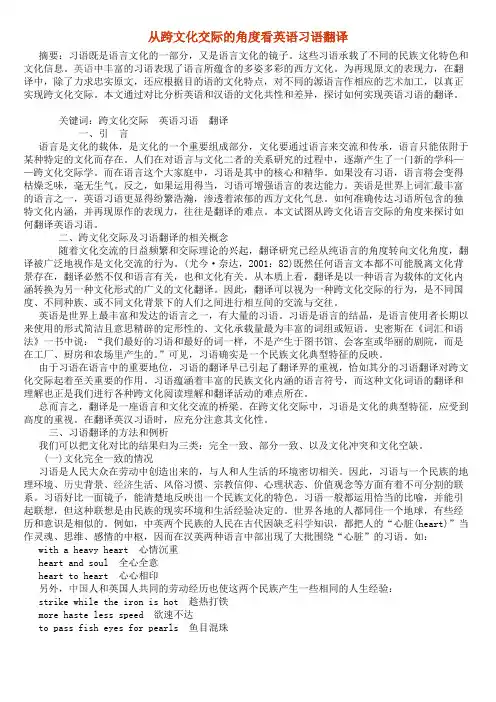
从跨文化交际的角度看英语习语翻译摘要:习语既是语言文化的一部分,又是语言文化的镜子。
这些习语承载了不同的民族文化特色和文化信息。
英语中丰富的习语表现了语言所蕴含的多姿多彩的西方文化。
为再现原文的表现力,在翻译中,除了力求忠实原文,还应根据目的语的文化特点,对不同的源语言作相应的艺术加工,以真正实现跨文化交际。
本文通过对比分析英语和汉语的文化共性和差异,探讨如何实现英语习语的翻译。
关键词:跨文化交际 英语习语 翻译 一、引 言语言是文化的载体,是文化的一个重要组成部分,文化要通过语言来交流和传承,语言只能依附于某种特定的文化而存在。
人们在对语言与文化二者的关系研究的过程中,逐渐产生了一门新的学科——跨文化交际学。
而在语言这个大家庭中,习语是其中的核心和精华。
如果没有习语,语言将会变得枯燥乏味,毫无生气。
反之,如果运用得当,习语可增强语言的表达能力。
英语是世界上词汇最丰富的语言之一,英语习语更显得纷繁浩瀚,渗透着浓郁的西方文化气息。
如何准确传达习语所包含的独特文化内涵,并再现原作的表现力,往往是翻译的难点。
本文试图从跨文化语言交际的角度来探讨如何翻译英语习语。
二、跨文化交际及习语翻译的相关概念 随着文化交流的日益频繁和交际理论的兴起,翻译研究已经从纯语言的角度转向文化角度,翻译被广泛地视作是文化交流的行为。
(尤今·奈达,2001:82)既然任何语言文本都不可能脱离文化背景存在,翻译必然不仅和语言有关,也和文化有关。
从本质上看,翻译是以一种语言为载体的文化内涵转换为另一种文化形式的广义的文化翻译。
因此,翻译可以视为一种跨文化交际的行为,是不同国度、不同种族、或不同文化背景下的人们之间进行相互间的交流与交往。
英语是世界上最丰富和发达的语言之一,有大量的习语。
习语是语言的结晶,是语言使用者长期以来使用的形式简洁且意思精辟的定形性的、文化承载量最为丰富的词组或短语。
史密斯在《词汇和语法》一书中说:“我们最好的习语和最好的词一样,不是产生于图书馆、会客室或华丽的剧院,而是在工厂、厨房和农场里产生的。
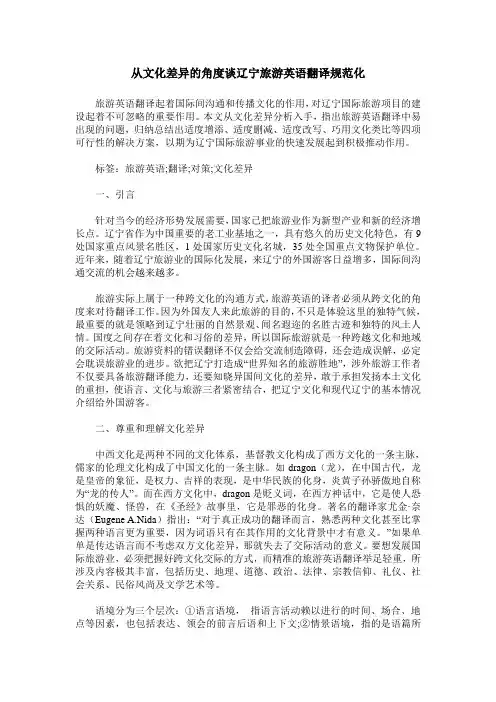
从文化差异的角度谈辽宁旅游英语翻译规范化旅游英语翻译起着国际间沟通和传播文化的作用,对辽宁国际旅游项目的建设起着不可忽略的重要作用。
本文从文化差异分析入手,指出旅游英语翻译中易出现的问题,归纳总结出适度增添、适度删减、适度改写、巧用文化类比等四项可行性的解决方案,以期为辽宁国际旅游事业的快速发展起到积极推动作用。
标签:旅游英语;翻译;对策;文化差异一、引言针对当今的经济形势发展需要,国家已把旅游业作为新型产业和新的经济增长点。
辽宁省作为中国重要的老工业基地之一,具有悠久的历史文化特色,有9处国家重点风景名胜区,1处国家历史文化名城,35处全国重点文物保护单位。
近年来,随着辽宁旅游业的国际化发展,来辽宁的外国游客日益增多,国际间沟通交流的机会越来越多。
旅游实际上属于一种跨文化的沟通方式,旅游英语的译者必须从跨文化的角度来对待翻译工作。
因为外国友人来此旅游的目的,不只是体验这里的独特气候,最重要的就是领略到辽宁壮丽的自然景观、闻名遐迩的名胜古迹和独特的风土人情。
国度之间存在着文化和习俗的差异,所以国际旅游就是一种跨越文化和地域的交际活动。
旅游资料的错误翻译不仅会给交流制造障碍,还会造成误解,必定会耽误旅游业的进步。
欲把辽宁打造成“世界知名的旅游胜地”,涉外旅游工作者不仅要具备旅游翻译能力,还要知晓异国间文化的差异,敢于承担发扬本土文化的重担,使语言、文化与旅游三者紧密结合,把辽宁文化和现代辽宁的基本情况介绍给外国游客。
二、尊重和理解文化差异中西文化是两种不同的文化体系,基督教文化构成了西方文化的一条主脉,儒家的伦理文化构成了中国文化的一条主脉。
如dragon(龙),在中国古代,龙是皇帝的象征,是权力、吉祥的表现,是中华民族的化身,炎黄子孙骄傲地自称为“龙的传人”。
而在西方文化中,dragon是贬义词,在西方神话中,它是使人恐惧的妖魔、怪兽,在《圣经》故事里,它是罪恶的化身。
著名的翻译家尤金·奈达(Eugene A.Nida)指出:“对于真正成功的翻译而言,熟悉两种文化甚至比掌握两种语言更为重要,因为词语只有在其作用的文化背景中才有意义。
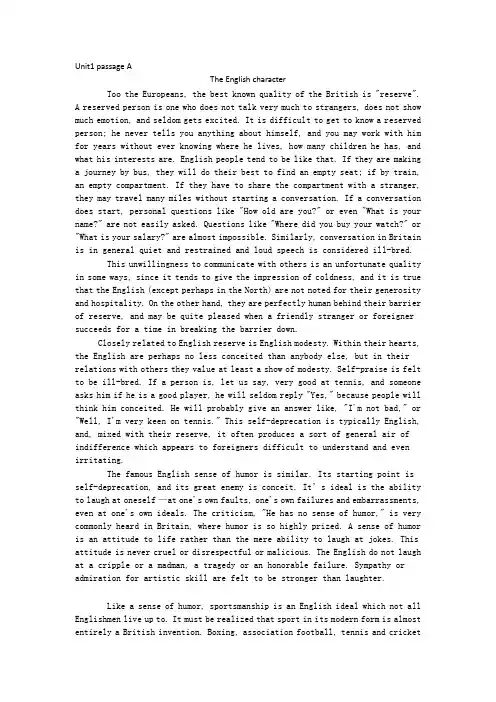
Unit1 passage AThe English characterToo the Europeans, the best known quality of the British is "reserve".A reserved person is one who does not talk very much to strangers, does not show much emotion, and seldom gets excited. It is difficult to get to know a reserved person; he never tells you anything about himself, and you may work with him for years without ever knowing where he lives, how many children he has, and what his interests are. English people tend to be like that. If they are making a journey by bus, they will do their best to find an empty seat; if by train, an empty compartment. If they have to share the compartment with a stranger, they may travel many miles without starting a conversation. If a conversation does start, personal questions like "How old are you?" or even "What is your name?" are not easily asked. Questions like "Where did you buy your watch?" or "What is your salary?" are almost impossible. Similarly, conversation in Britain is in general quiet and restrained and loud speech is considered ill-bred.This unwillingness to communicate with others is an unfortunate quality in some ways, since it tends to give the impression of coldness, and it is true that the English (except perhaps in the North) are not noted for their generosity and hospitality. On the other hand, they are perfectly human behind their barrier of reserve, and may be quite pleased when a friendly stranger or foreigner succeeds for a time in breaking the barrier down.Closely related to English reserve is English modesty. Within their hearts, the English are perhaps no less conceited than anybody else, but in their relations with others they value at least a show of modesty. Self-praise is felt to be ill-bred. If a person is, let us say, very good at tennis, and someone asks him if he is a good player, he will seldom reply "Yes," because people will think him conceited. He will probably give an answer like, "I'm not bad," or "Well, I'm very keen on tennis." This self-deprecation is typically English, and, mixed with their reserve, it often produces a sort of general air of indifference which appears to foreigners difficult to understand and even irritating.The famous English sense of humor is similar. Its starting point is self-deprecation, and its great enemy is conceit. It’s ideal is the ability to laugh at oneself —at one's own faults, one's own failures and embarrassments, even at one's own ideals. The criticism, "He has no sense of humor," is very commonly heard in Britain, where humor is so highly prized. A sense of humor is an attitude to life rather than the mere ability to laugh at jokes. This attitude is never cruel or disrespectful or malicious. The English do not laugh at a cripple or a madman, a tragedy or an honorable failure. Sympathy or admiration for artistic skill are felt to be stronger than laughter.Like a sense of humor, sportsmanship is an English ideal which not all Englishmen live up to. It must be realized that sport in its modern form is almost entirely a British invention. Boxing, association football, tennis and cricketwere all first organized and given rules in Britain. Rules are the essence of sport, and sportsmanship is the ability to practise a sport in obedience to its rules, while also showing generosity to one's opponent and good temper in defeat. Moreover, sportsmanship as an ideal is applied to life in general. One of the most elementary rules of life is "never hit a man when he's down"─in other words, never take advantage of another person's misfortune. English school-boys often show this sense of sportsmanship to a surprisingly high degree in their relations with each other.译文:对于其他欧洲人来说,英国人最著名的特点是“谨慎”。
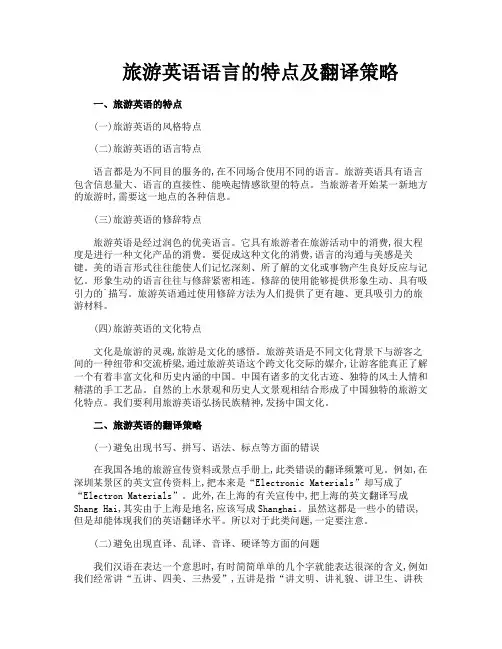
旅游英语语言的特点及翻译策略一、旅游英语的特点(一)旅游英语的风格特点(二)旅游英语的语言特点语言都是为不同目的服务的,在不同场合使用不同的语言。
旅游英语具有语言包含信息量大、语言的直接性、能唤起情感欲望的特点。
当旅游者开始某一新地方的旅游时,需要这一地点的各种信息。
(三)旅游英语的修辞特点旅游英语是经过润色的优美语言。
它具有旅游者在旅游活动中的消费,很大程度是进行一种文化产品的消费。
要促成这种文化的消费,语言的沟通与美感是关键。
美的语言形式往往能使人们记忆深刻、所了解的文化或事物产生良好反应与记忆。
形象生动的语言往往与修辞紧密相连。
修辞的使用能够提供形象生动、具有吸引力的`描写。
旅游英语通过使用修辞方法为人们提供了更有趣、更具吸引力的旅游材料。
(四)旅游英语的文化特点文化是旅游的灵魂,旅游是文化的感悟。
旅游英语是不同文化背景下与游客之间的一种纽带和交流桥梁,通过旅游英语这个跨文化交际的媒介,让游客能真正了解一个有着丰富文化和历史内涵的中国。
中国有诸多的文化古迹、独特的风土人情和精湛的手工艺品。
自然的上水景观和历史人文景观相结合形成了中国独特的旅游文化特点。
我们要利用旅游英语弘扬民族精神,发扬中国文化。
二、旅游英语的翻译策略(一)避免出现书写、拼写、语法、标点等方面的错误在我国各地的旅游宣传资料或景点手册上,此类错误的翻译频繁可见。
例如,在深圳某景区的英文宣传资料上,把本来是“Electronic Materials”却写成了“Electron Materials”。
此外,在上海的有关宣传中,把上海的英文翻译写成Shang Hai,其实由于上海是地名,应该写成Shanghai。
虽然这都是一些小的错误,但是却能体现我们的英语翻译水平。
所以对于此类问题,一定要注意。
(二)避免出现直译、乱译、音译、硬译等方面的问题我们汉语在表达一个意思时,有时简简单单的几个字就能表达很深的含义,例如我们经常讲“五讲、四美、三热爱”,五讲是指“讲文明、讲礼貌、讲卫生、讲秩序、讲道德”;四美是指“心灵美、语言美、行为美、环境美”;三热爱是指“热爱祖国、热爱社会主义、热爱中国共产党”;这七个字具有丰富的内容及思想性。
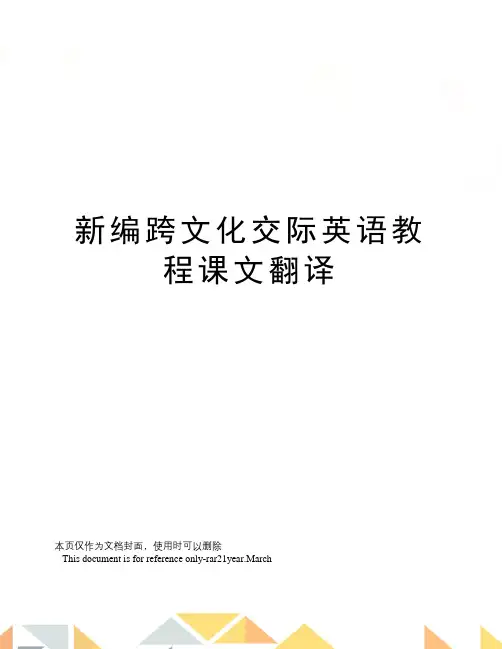
新编跨文化交际英语教程课文翻译本页仅作为文档封面,使用时可以删除This document is for reference only-rar21year.MarchU1reading1跨文化交际日益引起人们的注意的原因:是由于交通工具的进步与通讯手段的发展使得不同国家、不同种族、不同民族的人能够频繁地接触和交往。
L.S.Harms认为,在世界范围内的交际经历了五个阶段:A语言的产生; B文字的使用; C印刷技术的发明; D近百年交通工具的进步和通讯手段的迅速发展; E跨文化交际。
近二十年来的交际是以跨文化为特征的。
二、对跨文化交际的不同理解有的人认为每个人在文化上都是独特的,所以任何两个人之间的交际都是跨文化交际。
文化通常不是指个人的行为,而是指一个群体的生活方式和习惯。
作者认为作跨国、跨种族、跨民族.研究不仅应该是跨文化交际研究包括的内容,而且应该是放在首位的。
在研究一个国家的文化特点时,我们的眼光首先应集中在它的主流文化上,其次才注意它的亚文化和地区文化的特点含义:人们应用符号并借助媒介交流信息的行为与过程;人与人之间直接交往活动;通过媒介进行的信息交流与沟通活动。
人类传播的发展:信息符号传播:手势、有限的声音、体语符号、其它符号、实物口语传播媒介传播传播类型:非人类传播与人类传播伴随人类产生发生出现;不同民族相互接触与融洽的结果;交通和通讯工具的发展促进跨文化交际的发展含义:具有不同文化背景的人们之间进行的交际往来或信息传播与沟通活动文化在跨文化交际中的地位:是跨文化交际的核心;文化的复杂性影响跨文化研究;文化涵盖历史与现实、实物与制度及观念、稳定性与能动性、群体特点与地区及个体差异影响跨文化交际的主要因素:民族的历史与传统、宗教思想、价值观念、社会组织形式、风俗习惯、政治制度、社会发展阶段case1主角被埃及人邀请去家里吃丰盛的大餐,他用餐后说食物很好。
在这种情况下,理查德错误可能是他选择赞美食物本身,而不是整个晚上,的食物。
程 前一、引言文化属于一个抽象的概念,它具有多种存在形式。
不同地区的建筑风格、饮食习惯,抑或是文字,这些属于物质的、有形的文化。
当然,相对也存在精神文化,精神文化是在长期的物质生产生活的基础上逐渐形成的意识形态,它体现着人们的精神面貌和对待事物所采取的思维方式和处理方式。
在如今经济全球化的背景下,全球各个国家与地区的人们每时每刻都会以多种方式了解“外面的世界”,同时各种文化相互影响、相互渗透,各方政治、经济与文化等方面的交流在跨文化交际的过程中密不可分。
语言文字是沟通交流的重要方式。
准确领会异语所表达的话语内容、情感色彩才能促成更好的交际效果。
作为交际的重要媒介,翻译不仅仅是两种语言之间字词的简单转换,更应该充分考虑到文字背后可能存在的深层含义,这些深层含义是其创造过程中渗入的文化特色与情感,在此基础上,采用不同的翻译策略,使用恰当的翻译方法及技巧才能取得更好的翻译效果。
二、文化与语言“文化”一词,在日常生活中极为常见,它可以是各类学科知识和研究成果,也可以是某个地区的社会风气面貌,很难给出一个清晰、准确、完整的定义。
但随着社会的发展,“文化”可以分为广义文化与狭义文化两种。
“广义文化”指的是区别于自然界已存在物质的人类创造的所有成果,而“狭义文化”较为普遍,特指人类精神活动所创造的成果,涉及语言、艺术、社会风俗习惯、道德法制以及各种传统。
语言是文化的一种外在表现形式。
无论是发明之初人们为了方便记录储存,还是言语交流,每个民族都会创造自己独特的语言文字,并在长期的历史发展过程中受到自身文化和需求的影响不断变化,完善语言文字体系。
所以,透过某种语言便可知其文化,语言直接反映其文化内涵。
因此,对异种文化的了解领悟有助于跨语言交际。
三、中西文化差异人类创造出了多种多样的文化,但人的创造活动受制于多种因素。
人类活动基于自然界的物质,以自然界中的物质为基础进行创造。
在长期的文化创造过程中,中西方形成了相当大的文化差异,在日益频繁的中西文化交流中,两者之间的摩擦与碰撞也愈加明显,这也成为跨文化交际的一大障碍,因此,只有充分深入了解异种文化以及文化产生的根源,才能够消除交际障碍,进行更好的跨文化以及语言交流。
对旅游英语翻译中几个问题的思考文/彭明英英语是最重要的国际交流工具之一,世界上使用英语的人口一直在增加,而旅游业的发展又进一步巩固了英语作为全球语的重要地位。
旅游事业的不断发展需要懂英语的东道主,也需要素质良好的英文导游,旅游英语因此受到越来越多人的青睐。
旅游作为一种跨文化的交流行为,在翻译实践中必须研究旅游英语的特点,考虑文化因素和文体因素,不断积累中文和英文的语言文化知识,将翻译技巧与跨文化意识结合起来。
一、旅游英语的特点旅游业有鲜明的时代感、民族性、文化色彩和地方特征,旅游英语与旅游业联系紧密,也有与之相适应的独特语言风格。
1.旅游英语具有唯美的语言特征旅游者在旅游活动中的消费,很大程度是文化产品的消费。
要促成这种文化消费,语言的沟通与美感是关键。
旅游英语作为对外宣传中国的载体,是经过加工提炼并符合美学要求的。
旅游英语传达着独特的文化内容,作为宣传中国文化与吸引中外游客观光游览的国际宣传媒介,除了恰如其分地表达主题内容,还应较多地侧重于对美的事物的描述,并要把优秀美好的中国文化发扬光大。
2.旅游英语是经过润色的优美语言美的旅游文化内容需要用美的语言形式来体现,美的语言形式往往能使人们对所了解的文化或事物产生良好的反应与记忆,语言愈生动,愈形象,愈能上口,人们就愈易感知和掌握。
赏析旅游英语的过程不仅是掌握一种语言,它本身也是一种智能的训练和美学的修养。
旅游英语包括了丰富的语言文化内涵,文化是旅游的灵魂,旅游是文化的感悟。
对每个旅游者来说,不仅仅是观光和享受,还自觉不自觉地接受了某种文化的影响。
与之相对应,旅游英语中除了旅游专业术语外,还包含了一系列具有文化底蕴的语言文字材料。
旅游英语的语言文化范畴中,有浅层文化,也有深层文化。
旅游英语在表达文化意念时带有浪漫主义的语言文化特点,也表现出写真务实的语言文化现象。
作为跨文化交际之媒介,旅游英语的语言文化特征也就显得更为突出。
二、旅游英语翻译的理论依据与策略翻译目的论可以为旅游英语翻译提供有力的依据,目的论(moral teleology)认为,翻译应该遵循的最重要的规则是“目的法则”,翻译行为的目的决定整个翻译行为的过程。
Speaki ng Englis h with a Japane se mind 日本人在达到上学年龄后就要学英语,这些人在学会英语之后就可能用英语进行对外交流,但是他们所使用的英语要受到他们本民族的语言和文化的影响。
因此这就会造成困扰和误解在与其他用英语的人交流时。
AM,当他作为索尼公司的首席执行官时,在一次给美国的商学会做报告时他指出了这两种语言的明显差异。
他举了一个例子,一个美国商人向他的一个日本生意上的伙伴提议了一项计划。
可是当美国人完成时,日本人才开始谈论这个项目听起来多么有趣并且他们公司也有同样的想法。
美国人认为这个项目肯定会被接受。
但是随着辩论的拖延,美国人的关注也开始减弱,然后日本人说,不管怎样。
AM告诫说,接下来就是你要仔细听的时候了。
因为真正的回答是在那个词语的后面。
他经常告诫他的部下官员要用一种大多数的使用英语的人都习惯的方式说话,如果他想被别人理解。
他还告诫说,在日本你可能是大多数,但是到了国外你就是一小部分。
要想用一种大多数人都能最大限度的理解你的方式说话需要更多的语法知识和大量的词汇。
你必须对你所谈话的那个人的交流方式,社交礼仪,价值观等等很熟悉。
日本人的说话顺序正好和说英语的人相反。
甚至就是一个非常简单的句子,比如英国人会说,你得带伞因为要下雨。
而日本人会说,因为会下雨所以你要带伞。
不管这种正常的表达方式的顺序是否会控制想法顺序还是什么,日本人这种用不同顺序的表达信息的方式会让那些说英语的国家的人且对日本语言不了解的人感到困惑。
另一个例子就是,一些说英语的日本人和美国的一些领导举行卫星电视会议来讨论两国间的经济和贸易关系。
日本的参会者说着流利的英语,同时会被翻译成日语以供那些不懂得英语的人理解。
最新英语专业全英原创毕业论文,都是近期写作英语法律文本翻译原则从文化视角浅谈旅游英语翻译英汉白色词的文化象征意义及翻译论应变能力在同声传译中的应用英语学习中的性别差异班德瑞曲名汉译策略之解析阶级矛盾导致的爱情悲剧―<<呼啸山庄>>解读论英语中的汉语借词(开题报告+论)跨文化交际中的语用失误分析及策略研究文档所公布均英语专业全英原创毕业论文。
原创Q 805 990 74 9《蝴蝶梦》中的女性成长主题研究简析《卡斯特桥市长》中亨查德的悲剧命运艺术与现实之间的冲突--解读毛姆的《月亮和六便士》Translation Strategies of Two-part Allegorical Sayings《红楼梦》两英译本文化不可译性之管窥中学英语教育中的情感教育“上”和“下”的意象图式及概念映射《彼得潘》中彼得潘形象分析从涉外婚姻分析中西方文化差异中西方酒文化对比分析美剧对中国年轻人的影响中美学生对待教师的礼貌言行的对比分析对比分析苔丝和蓓基--哈代《德伯家的苔丝》和萨克雷《名利场》An Ecofeministic Approach to Ernest Hemingway’s “Hills Like White Elephants”(开题报告+论文+文献综述)女性的自我迷失与回归—从女性主义视角解读《蒂凡尼的早餐》(开题报告+论文)凯特•肖邦小说《觉醒》中的超验主义思想分析从功能翻译理论看《风声》的字幕翻译策略金融危机对中美人民经济生活造成不同影响的文化根源从文化的角度审视中西习语的来源非传统式英雄——从女性主义批评角度看《名利场》浅析《儿子与情人》的人物刻画的技巧爱德华•摩根•福斯特《最漫长的旅程》的主题研究An analysis of the "never lost" qualities on Hemingway and his Sun Also Rises女性主义视角下《小妇人》中四姐妹的人物分析从李安的父亲三部曲看中西方价值观的差异论英语教学中的非智力因素中英委婉语语用功能的对比研究论《献给艾米莉的玫瑰》中的悲剧之源论初中英语教学中的教师角色扮演A Study on Narrative Techniques in A Rose for Emily从目的论看中国企业简介的英译论英汉植物词语的文化附加义奈达功能对等理论指导下英汉广告修辞的翻译策略探究中英征婚广告对比分析研究浅析跨文化交际中的英汉道歉语及其策略对外新闻的导语编译研究习语翻译中的文化缺省和补偿《屋顶上的女人》和A & P 中的人物比较及分析论中学英语教学中各种教学法的融合与运用Influences of Chinese Classical Poetry on Ezra Pound从中西方文化差异的角度浅谈吉祥语的翻译从用餐礼仪看中美核心价值观差异浅析薇拉·凯瑟《啊,拓荒者!》的艺术特色英语广告语言特点分析论“迷惘的一代”--以海明威为个案“反偶像的偶像”乔治奥威尔An Analysis of Conflicts between Heroines in The Prime of Miss Jean Brodie从Salsa舞解析墨西哥人的性格交际法在初中英语教学中的运用英语课堂中的非传统学习策略从跨文化角度谈英语词汇的教与学中英色彩词的文化内涵异同分析教学设计理论对初中英语教学的启示刍议从功能派翻译理论的角度研究中国菜单翻译浅析动植物词汇中的中英文化差异On Application of Skopostheo ry in Translation of A Midsummer Night’s Dream浅析《心是孤独的猎手》的精神隔绝主题浅析田纳西•威廉斯剧作《欲望号街车》的同性恋倾向论企业简介中文到英文的翻译The Analysis of Teacher Images in English Films And Their Impacts on Young Teachers 从许渊冲的“三美论”看唐诗中的典故翻译商务英语信函中的礼貌原则从清教理想主义角度解读《红字》中的和谐思想英语姓名的文化内涵初中英语教学中的兴趣教学法灰姑娘情结在《理智与情感》中的表现论中西方交际方式的差异从功能对等理论谈中国小吃名英译从电影《阿甘正传》分析委婉语的交际功能浅析科技英语的文体特点A Comparison of the English Color Terms卡森•麦卡勒斯《心是孤独的猎手》福柯式解读从目的论的角度浅析美国电影字幕翻译工业化进程下人的主体性的追问——梭罗的《瓦尔登湖》论哥特式手法在《呼啸山庄》中的应用希拉里退选演讲积极话语分析《夜莺与玫瑰》和《快乐王子》中奥斯卡•王尔德的唯美主义海明威《太阳照样升起》中的象征主义浅析星巴克现象中的独特文化Scarlett的人物形象分析一项有关影响中国学生英语听力理解的因素的调查研究Cultural Differences Between English and Chinese by Analyzing Brand Names 从《永别了,武器》看海明威的战争观浅析英语习语的翻译原则和方法从文化视角浅析英汉数字的翻译高中英语写作中母语负迁移现象分析功能对等与商务信函翻译从《尼克亚当斯故事》中探析父亲情结对海明威人生观的影响An Analysis of Young Goodman Brown from the Perspective of Symbolism从功能主义理论看莫言《酒国》中脏话的翻译论个人主义对美国英雄电影的影响福克纳对女性形象的塑造—以《献给艾米丽的玫瑰》和《士兵的报酬》为例透过《傲慢与偏见》论简奥斯丁的婚姻观从电视剧《绝望主妇》看委婉语的交际功能阿加莎克里斯蒂侦探小说中的罪犯形象跨文化交际中的中西方饮食文化差异《麦田里的守望者》中主人公的性格分析《红字》中丁梅斯代尔的灵魂救赎从功能翻译理论看汉语公示语的英译《警察与赞美诗》和《重新做人》中主人公的不同命运To Foster Pupils’Interests in English Teaching“到十九号房间”的悲剧成因A Comparison of the English Color Terms论夏绿蒂勃朗特与简爱在意识形态上的相似之处从功能翻译理论视角看《破产姐妹》的字幕翻译英语广告的批评性话语分析论英语专业八级口语测试的内容效度剖析《麦田里的守望者》主人公霍尔顿的复杂个性《宠儿》中的女性形象分析The Symbolic Meaning of Setting and Characters in Howards End从中西文化差异角度谈品牌翻译浅析马拉默德小说《店员》中的“犹太性”从礼貌原则分析发盘的语言技巧“垮掉的一代”没有垮——简析《在路上》中年轻人的生活观《呼唤》中倒装句汉译策略研究广告中的文化因素“庸人”自扰——《普鲁弗洛克情歌》主题探究由《红楼梦》中人名的英译看中西文化差异《哈利•波特》系列作品中颜色的象征意义《夜色温柔》男主人公迪克的精神变化研究On China English as A Localized Variety of English and its Implications for ELT心理效应对后进生学习影响之探究斯嘉丽---一朵铿锵的玫瑰从死亡委婉语中透视中西方文化差异A Study of Maggie’s Tragedy in The Mill on the Floss论翻译的艺术解析《呼啸山庄》中凯瑟琳的精神之旅An Analysis of Translation Strategies on Chinese Catchwords从《推手》看中美文化差异对家庭关系的影响美国电视剧中双关语的研究-重点关注双关语的汉语翻译《夜色温柔》男主人公迪克的精神变化研究论格列佛人物形象在《格列佛游记》中所起的讽刺效果跨文化交际中文化移情能力的培养英文歌曲名称翻译浅析General Principles and Features of Legal English Translation析《远大前程》主人公匹普的性格成长历程浅析《小妇人》中乔的女性意识及其成长过程浅析《了不起的盖茨比》中的象征主义解读《献给艾米丽的一朵玫瑰花》中“玫瑰”的象征意义欧•亨利短篇小说的特点一个为追求自我挣扎的灵魂——看凯特•肖邦的《觉醒》On the Translation of Communicative Rhetoric in Literature—Analysis of the two Chinese versions of Jane Eyre中美礼貌用语的跨文化对比分析原罪与拯救:《小伙子布朗》与《好人难寻》比较言语行为理论下的英语广告双关小说《鲁滨逊漂流记》中的精神力量分析The Importance of the Application of Kinesics in English Classes in Primary School从跨文化传播角度论中国饮食文化资料的英译论《红字》中丁梅斯代尔的双面性《麦田里的守望者》主人公的性格分析分析中国和美国的慈善文化Perseverance in Belief—On the Death of Martin Eden浅析译者主体性在张培基散文翻译中的体现—以《落花生》的英译为例课本剧在高中英语教学中的应用与研究马克吐温小说的语言特征Saussure’s Five Co ntributions to Linguistic Study and Its Modern Applications论杰克伦敦的个人经历和信仰对《野性的呼唤》主人公巴克命运的影响从《太阳照常升起》分析美国一战后的消费道德观法律英语词汇特点及其翻译中餐菜单英译的归化与异化《红字》中霍桑的女性观文化对在校英语学习的重要性论英汉成语翻译欲望与命运--《推销员之死》与《旅行推销员之死》中主人公的悲剧根源之比较美国文学中的美国梦研究从认知视角谈英语学习中的负迁移海明威“冰山原理”在《永别了,武器》中的应用及对写作的指导意义Cultural Differences and TranslationA Study of Cultural Differences Reflected in Chinese and English Proverbs论《哈利波特》中的情感结构纳博科夫小说《洛丽塔》的爱情讽刺古诗词英译关于夸张的翻译策略研究诗歌《飞鸟集》的意象评析少儿英语游戏教学策略研究从归化和异化的角度看英语人名的翻译Translation of Gududeqiu from the Pe rspective of Qian Zhongshu’s Realm of Sublimation 霍桑及其矛盾思想在《红字》中的体现汉英习语翻译及其所反映的文化差异“中式英语”和“中国英语”两个概念的区别研究:以公示语为例数字模糊语义的汉英翻译英汉思维差异与翻译策略论《等待戈多》中的荒诞与象征中西文化中的颜色内涵之异同凯特•肖邦作品中女性自我意识觉醒的主题研究商务演讲中的跨文化障碍《月亮与六便士》中查尔斯•思特里克兰德的追寻自我从《警察与赞美诗》看欧亨利式结尾海明威的“冰山原则”与其短篇小说的人物对话《红楼梦》两英译版本中姓名翻译的对比研究。
中国最大的论文知识平台www.lwxiezuo.com 摘 要 本文首先阐述了跨文化交际的定义、起源和发展,随后探讨了文化意识和文化差异,对中西方文化在旅游方面的差异进行了对比,并指出将翻译技巧与跨文化意识相结合应是译者的一种基本技能。接着,作者通过案例分析,阐述了如何将跨文化理论应用于旅游英语的翻译实践中。最后,作者对旅游英语翻译的重要性以及在翻译中应该采取的策略进行了总结。
关键词:跨文化交际;差异;旅游英语;翻译 中国最大的论文知识平台www.lwxiezuo.com
ABSTRACT This paper firstly briefly deals with the definition of intercultural communication, the beginning and the development of intercultural communication. Then it analyzes cultural awareness and the cultural difference, the difference between the east and west, and puts forward the idea that translation of English for Tourism should be done in an intercultural perspective, and it should be done skillfully when translating. On the basis of the above study, the practical example of the translation of tourist materials comes out. It is emphasized that intercultural awareness should run through the whole process of translating tourist materials. In the conclusion, the author restates the importance of translating tourism English and sums up some strategies adopted in translation.
Key words:Intercultural communication; difference; tourism English; translation 中国最大的论文知识平台www.lwxiezuo.com
Contents 1.Introduction ................................................................................................................. 51 2. Intercultural Communication ...................................................................................... 53 2.1 Definition ....................................................................................................................... 53 2.2 Origin ............................................................................................................................. 54 2.3Development of Intercultural Communication‟s Application in Tourism Translation ................................................................................................................... 54
3. Intercultural Communication Difference in Tourism Translation............................ 57 3.1 Difference in Vocabulary ............................................................................................... 57 3.2 Difference in Syntax Structure ...................................................................................... 58 3.3 Difference in Culture ..................................................................................................... 59 3.3.1 Difference in Psychology ........................................................................................... 60 3.3.2 Difference in Conventions .......................................................................................... 60 3.3.3 Difference in Historical Culture ................................................................................. 61 3.3.4 Difference in Thinking Modes ................................................................................... 61 3.3.5 Difference in Aesthetic Taste ...................................................................................... 62 4. Intercultural Communication Awareness in Tourism Translation ........................... 63 4.1 Translation from Intercultural Perspective .................................................................... 63 4.2 Case Studies ................................................................................................................... 64 5.Conclusion .................................................................................................................... 69 Acknowledgements ............................................................................ 错误!未定义书签。 References........................................................................................................................... 71 中国最大的论文知识平台www.lwxiezuo.com
1.Introduction Nowadays, tourism has become one of the most important and growing industries in the rapidly changing world. The authoritative World Travel and Tourism Council declared that tourism is one of the world‟s largest industries. The theme of the 27th Tourism Day is “Tourism Enriches”, which emphasizes the active role the tourism plays in boosting the world economy, cultural communication and social development. The development of travel industry has, in turn, exerted a tremendous influence on the economies and cultures of the world. Tourism creates the need to communicate with people of various cultural backgrounds. The contacts between foreign visitors and us are an intercultural communication. Given the frequent cultural exchanges in tourism industry, a further study into translation of English for tourism in an intercultural perspective is a must. That means translators have to adopt intercultural awareness when rendering source language into target language so that the version in target language is more culturally acceptable, especially when rendering Chinese publicity materials into English. As for tourism service, translation in an intercultural perspective aims at exploring efficient ways to relate to or communicate with foreign visitors who speak a different language and live in a different culture. Translation plays a very important role in tourism service. To be more accurate, translation can be construed as intercultural translation as well as inter-language translation. The purpose of translation is to provide foreign readers useful information, including culture-loaded information. Intercultural communication (cross-cultural communication) is communicative activities done by people of different cultural backgrounds. Therefore, translation done within an intercultural communication is of great practical significance. Concerning tourism translation, Since the 1980s major tourism translation research can be roughly classified into three categories: culture, landscape descriptions and both culture and landscape descriptions. The researchers